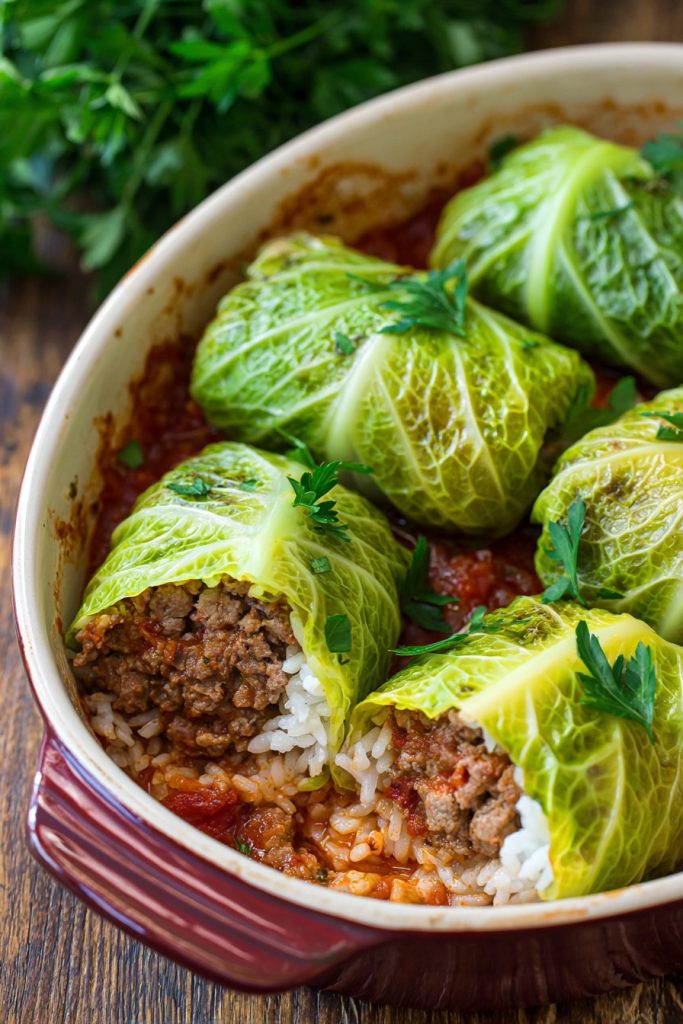These cabbage rolls represent the pinnacle of comfort food craftsmanship, featuring blanched cabbage leaves enveloping a meticulously seasoned ground meat and rice filling, all simmered in a rich tomato-based sauce until perfectly tender. The technique-driven approach ensures consistent results every time, with attention to proper leaf preparation, filling distribution, and cooking methodology that separates amateur attempts from professional execution.
Why This Recipe Works
- The blanching technique for cabbage leaves employs precise temperature control and timing to achieve optimal pliability without compromising structural integrity, allowing for tight rolling while maintaining distinct leaf layers in the final product.
- Utilizing a combination of ground pork and beef creates superior flavor complexity and textural contrast, with the pork contributing fat content for moisture retention and the beef providing robust savory notes that stand up to extended simmering.
- The rice component undergoes partial cooking before incorporation, ensuring proper starch gelatinization while preventing excessive absorption of the filling’s moisture during the final cooking phase, resulting in perfectly textured grains within the roll.
- Layering the rolls in the cooking vessel with strategic sauce distribution creates a self-basting environment where steam circulates evenly, promoting uniform doneness while preventing drying or uneven cooking across the batch.
- The tomato-based sauce employs a dual preparation method where aromatics are sautéed to develop foundational flavors before tomato products are added, creating depth that simple combining cannot achieve.
Ingredients
- 1 large head green cabbage (approximately 3 pounds), core intact
- 1 pound ground pork (80/20 fat ratio)
- 1 pound ground beef (85/15 fat ratio)
- 1 cup long-grain white rice, rinsed and drained
- 1 large yellow onion, finely diced (about 2 cups)
- 4 cloves garlic, minced
- 2 large eggs, lightly beaten
- 1/4 cup whole milk
- 2 tablespoons unsalted butter
- 2 tablespoons olive oil
- 1 (28-ounce) can crushed tomatoes
- 1 (15-ounce) can tomato sauce
- 1/4 cup tomato paste
- 2 cups beef broth
- 1/4 cup brown sugar
- 3 tablespoons apple cider vinegar
- 2 teaspoons smoked paprika
- 1 teaspoon dried thyme
- 2 bay leaves
- 1/4 cup chopped fresh parsley
- Kosher salt and freshly ground black pepper
Equipment Needed
- 8-quart stockpot with lid
- Large mixing bowls
- 10-inch skillet
- 9×13-inch baking dish
- Sharp chef’s knife
- Cutting board
- Kitchen tongs
- Slotted spoon
- Instant-read thermometer
- Wooden spoon
- Measuring cups and spoons
Instructions

Cabbage Leaf Preparation and Blanching
Begin by preparing the cabbage leaves for optimal pliability and structural integrity. Fill your 8-quart stockpot with 6 quarts of water and bring to a rolling boil over high heat, maintaining a temperature of 212°F. While the water heats, carefully remove any damaged outer leaves from the cabbage head. Using a paring knife, make a shallow circular incision around the core to facilitate leaf separation during blanching. Submerge the entire cabbage head into the boiling water for precisely 3 minutes, then immediately transfer to an ice water bath to halt the cooking process. The blanching technique should render the outer leaves flexible enough to separate without tearing, which typically requires removing 12-16 usable leaves. For leaves that remain resistant, return the cabbage to boiling water for additional 30-second intervals until all desired leaves separate cleanly. Pat each leaf dry with paper towels, then use a sharp knife to shave down the thick central rib on each leaf to ensure even rolling and consistent thickness throughout the finished roll.
Filling Preparation and Component Integration
Prepare the filling components with attention to proper technique and ingredient integration. In your 10-inch skillet, heat 1 tablespoon of olive oil over medium heat until it shimmers, then add the rinsed long-grain white rice. Toast the rice for 4-5 minutes, stirring constantly, until the grains become opaque and develop a nutty aroma. Add 1 1/4 cups of water and bring to a simmer, then cover and cook for 12 minutes until the rice has absorbed most liquid but remains slightly undercooked at the core. Transfer the parcooked rice to a large mixing bowl to cool. In the same skillet, melt 2 tablespoons of unsalted butter over medium heat and sauté the finely diced yellow onion until translucent and lightly caramelized, approximately 8-10 minutes. Add the minced garlic during the final minute of cooking to prevent burning. Combine the ground pork and beef in the mixing bowl with the cooled rice, incorporating the sautéed onion-garlic mixture, 2 lightly beaten eggs, 1/4 cup whole milk, 2 teaspoons kosher salt, and 1 teaspoon freshly ground black pepper. Mix using a folding motion until just combined to avoid overworking the meat proteins.
Roll Assembly and Structural Technique
Execute the rolling technique with precision to ensure uniform shape and secure closure. Lay a prepared cabbage leaf on your work surface with the stem end facing you and the shaved rib side up. Place approximately 1/3 cup of the meat-rice mixture in the center of the leaf, forming a rectangular shape about 3 inches long and 1 1/2 inches wide. Fold the stem end of the leaf over the filling, then bring the sides inward, and roll tightly toward the leaf tip, creating a compact cylinder. The tension should be firm enough to hold the roll together during cooking but not so tight that the filling squeezes out. Repeat this process with all prepared leaves, arranging the completed rolls seam-side down on a baking sheet. Professional technique note: maintain consistent filling amounts across all rolls to ensure even cooking times and portion sizes. The rolling method creates multiple layers of cabbage that will steam and soften during the final cooking phase while containing the flavorful filling within a natural wrapper.
Sauce Development and Flavor Layering
Construct the tomato-based sauce with proper technique to develop complex flavor profiles. In the same 10-inch skillet used previously, heat the remaining tablespoon of olive oil over medium heat. Add 1/4 cup of tomato paste and cook for 3-4 minutes, stirring constantly, until the paste darkens to a brick-red color and develops a slightly caramelized aroma. This crucial step, known as “frying the tomato paste,” deepens the flavor base significantly. Deglaze the skillet with 3 tablespoons of apple cider vinegar, scraping any browned bits from the bottom, then add the 28-ounce can of crushed tomatoes, 15-ounce can of tomato sauce, 2 cups of beef broth, 1/4 cup brown sugar, 2 teaspoons smoked paprika, 1 teaspoon dried thyme, and 2 bay leaves. Bring the sauce to a simmer, then reduce heat to low and cook uncovered for 15 minutes, allowing the flavors to meld and the sauce to reduce slightly. Season with 1 teaspoon kosher salt and 1/2 teaspoon black pepper, then remove the bay leaves before proceeding.
Final Assembly and Controlled Simmering
Execute the final cooking phase with temperature control and timing precision. Spread 1 cup of the prepared tomato sauce evenly across the bottom of your 9×13-inch baking dish. Arrange the cabbage rolls in a single layer, seam sides down, packing them snugly but not overcrowded. Pour the remaining sauce over the rolls, ensuring complete coverage. Cover the baking dish tightly with aluminum foil, creating a secure seal to trap steam during cooking. Place in a preheated 350°F oven and bake for 1 hour and 15 minutes. After this initial cooking period, remove the foil and continue baking for an additional 30 minutes to allow the sauce to reduce slightly and the tops of the rolls to develop a richer color. The internal temperature of the filling should register 165°F on an instant-read thermometer when properly cooked. Allow the cabbage rolls to rest for 15 minutes before serving to allow the starches in the rice to set and the flavors to equilibrate throughout the dish.
Tips and Tricks
For cabbage leaves that prove particularly resistant to separation during blanching, employ the freezing method: place the entire head of cabbage in the freezer overnight, then thaw completely before attempting to separate leaves. The ice crystals that form during freezing rupture cell walls, naturally tenderizing the leaves and making separation significantly easier. When working with the filling mixture, chill all components thoroughly before combining and maintain the mixture at temperatures below 40°F until ready to use; this prevents fat rendering prematurely and ensures proper binding during cooking. For superior texture in the finished rolls, consider substituting half the white rice with cooked pearl barley, which provides a pleasant chewiness and nutty flavor that complements the savory meat components.
When assembling rolls for larger gatherings, prepare them a day in advance through the rolling stage, then refrigerate covered overnight before adding sauce and baking. This resting period allows the cabbage leaves to absorb moisture from the filling, resulting in more tender final texture. For sauce refinement, after the initial simmering phase, use an immersion blender to partially puree the sauce, creating a smoother consistency that coats the rolls more evenly while still maintaining some textural interest. If your cabbage leaves are smaller than ideal, utilize the patch technique: overlap two smaller leaves slightly, place the filling at the junction, and roll as a single unit; the natural pectin released during cooking will seal the leaves together seamlessly.
For dietary modifications without compromising texture, replace the ground meats with a combination of finely chopped mushrooms (cremini work exceptionally well) and cooked lentils, using an additional egg as binder. The mushroom-lentil combination provides adequate structural integrity and umami depth that mimics meat characteristics. When testing for doneness, insert a thin-bladed knife into the center of a roll; the rice should be fully tender with no hard core, and the cabbage should offer no resistance when pierced. For service presentation, garnish with freshly chopped parsley and a drizzle of high-quality olive oil just before serving to add brightness and visual appeal to the finished dish.
Recipe Variations
- Mediterranean-Inspired Version: Replace the traditional meat filling with a combination of ground lamb, toasted pine nuts, and golden raisins soaked in red wine. Incorporate fresh mint and oregano into the herb profile, and use a sauce base of crushed tomatoes with cinnamon and allspice for authentic Greek flavor notes. The sweet and savory elements create complexity that elevates the dish beyond traditional preparations.
- Vegetarian Adaptation: Utilize a duxelles of finely chopped cremini mushrooms sautéed with shallots as the primary filling component, combined with cooked farro, roasted red peppers, and feta cheese. The mushroom farro mixture provides substantial texture and umami depth that satisfies even meat-eaters, while the feta adds salty tang that cuts through the richness of the tomato sauce.
- Asian Fusion Interpretation: Prepare the cabbage leaves using the traditional blanching method but fill with a mixture of ground pork, finely chopped shiitake mushrooms, water chestnuts, and cooked jasmine rice seasoned with ginger, garlic, and soy sauce. Instead of tomato sauce, use a braising liquid of chicken stock, rice wine, and hoisin sauce, finishing with scallions and sesame oil.
- Low-Carb Modification: Replace the rice component entirely with riced cauliflower that has been roasted to remove excess moisture. Increase the ground meat ratio to maintain volume, and incorporate grated Parmesan cheese into the filling for additional binding power. The roasting technique for the cauliflower prevents sogginess and creates a texture remarkably similar to traditional rice-filled versions.
Frequently Asked Questions
Can I prepare cabbage rolls ahead of time and refrigerate before cooking?
Yes, cabbage rolls are excellent candidates for advance preparation. After assembling the rolls but before adding the sauce, arrange them in your baking dish, cover tightly with plastic wrap, and refrigerate for up to 24 hours. This resting period actually improves the final texture as the cabbage leaves absorb moisture from the filling, resulting in more tender results. When ready to cook, remove from refrigeration 30 minutes before baking to take the chill off, then proceed with saucing and baking as directed, adding approximately 10-15 minutes to the covered baking time to account for starting from a colder temperature.
What’s the best method for freezing fully cooked cabbage rolls?
For optimal freezing results, allow the fully cooked cabbage rolls to cool completely to room temperature, then arrange them in a single layer on a parchment-lined baking sheet and flash freeze until solid, approximately 2 hours. This individual freezing prevents them from sticking together. Transfer the frozen rolls to airtight freezer containers, separating layers with parchment paper, and pour any remaining sauce over the top. Properly packaged, they will maintain quality for up to 3 months. To reheat, place frozen rolls in a baking dish, cover with additional tomato sauce or broth to prevent drying, and bake covered at 350°F for 45-60 minutes until heated through to 165°F internal temperature.
My cabbage rolls always fall apart during cooking – what am I doing wrong?
Structural failure typically results from three common issues: insufficient blanching of cabbage leaves, overfilling, or improper rolling technique. Ensure your blanching process renders leaves pliable enough to bend without cracking – if leaves resist, return to boiling water for additional 30-second intervals. Measure filling precisely using a 1/3 cup measure for consistency, and avoid overpacking. The rolling technique is crucial: fold stem end over filling, bring sides inward snugly but not tightly, then roll toward the tip with firm but gentle pressure. Finally, always place rolls seam-side down in the baking dish to weight them during cooking, and ensure adequate sauce coverage to steam the rolls properly rather than boiling them aggressively.
Can I use savoy cabbage instead of regular green cabbage?
Savoy cabbage makes an excellent substitute with some considerations. The more delicate, crinkled leaves of savoy cabbage require reduced blanching time – approximately 2 minutes rather than 3 – to achieve pliability without becoming too fragile. The thinner leaves cook more quickly, so reduce the covered baking time by 15-20 minutes to prevent overcooking. Savoy cabbage offers a more delicate texture and slightly sweeter flavor profile that pairs beautifully with the tomato sauce. However, the looser leaf structure may require more careful handling during rolling, and you may need additional leaves since they are typically smaller than standard green cabbage leaves. The finished dish will have a more refined, delicate character when using savoy cabbage.
Summary
Mastering cabbage rolls requires precision in leaf preparation, filling development, and controlled simmering techniques. The blanching method ensures pliable leaves, while the meat-rice filling benefits from proper component integration and seasoning balance. The layered cooking approach in tomato sauce creates tender, flavorful results that showcase professional technique and attention to detail throughout the process.
Cabbage Rolls
4
servings45
minutes1
minutesIngredients
Instructions
- 1 Blanch cabbage leaves in boiling water for 3 minutes, then ice bath. Shave thick ribs.
- 2 Toast rice in oil, then cook with water for 12 minutes until parcooked.
- 3 Sauté onion in butter until translucent, add garlic last minute.
- 4 Combine meats, rice, onion mixture, eggs, milk, and seasonings.
- 5 Place 1/3 cup filling on each leaf, fold sides, and roll tightly.
- 6 Make sauce by frying tomato paste, adding remaining ingredients, simmering 15 minutes.
- 7 Arrange rolls in baking dish, cover with sauce, bake covered 1 hour 15 minutes at 350°F.
- 8 Uncover and bake 30 minutes more until internal temperature reaches 165°F.
- 9 Rest 15 minutes before serving garnished with parsley.



